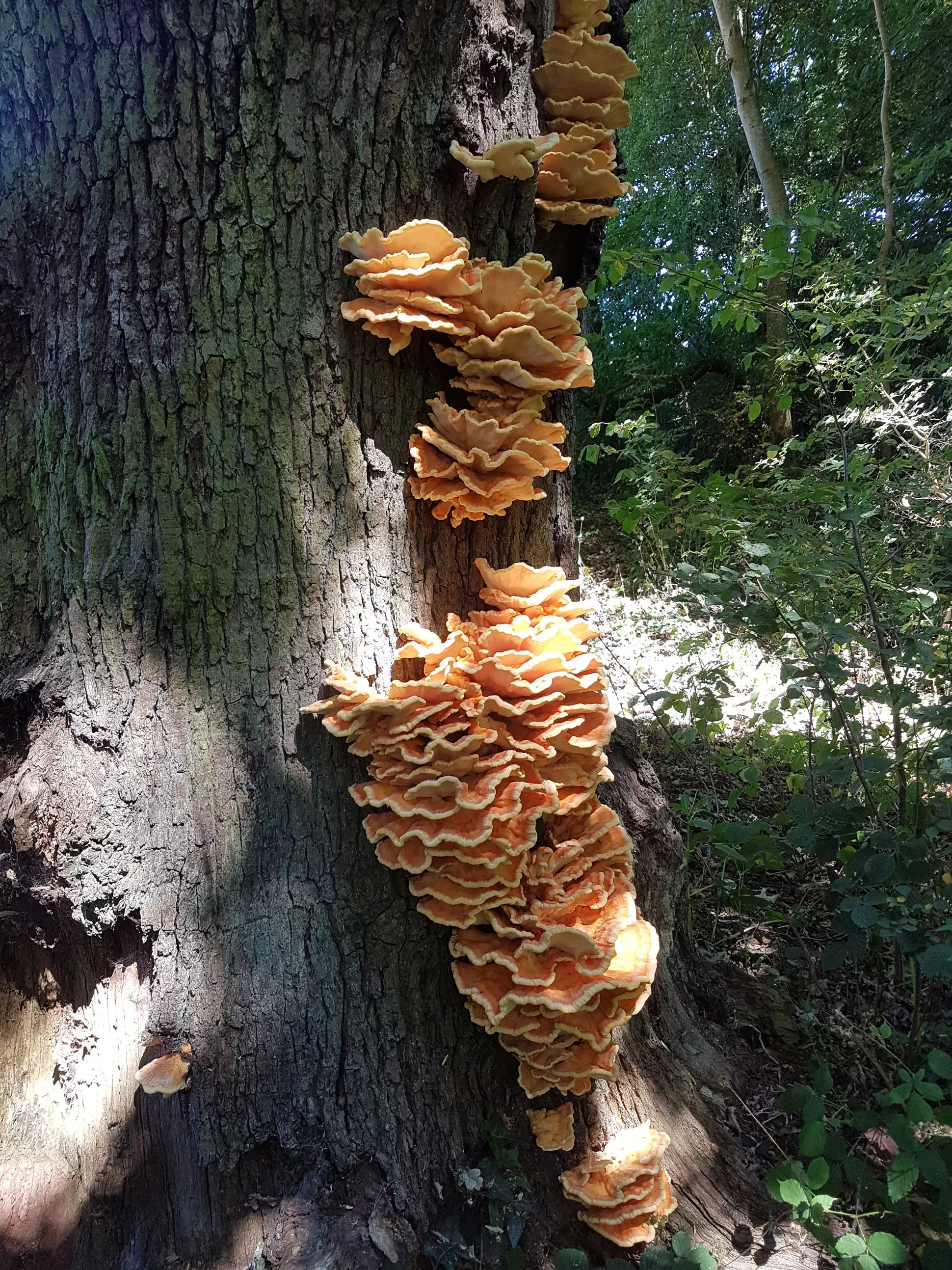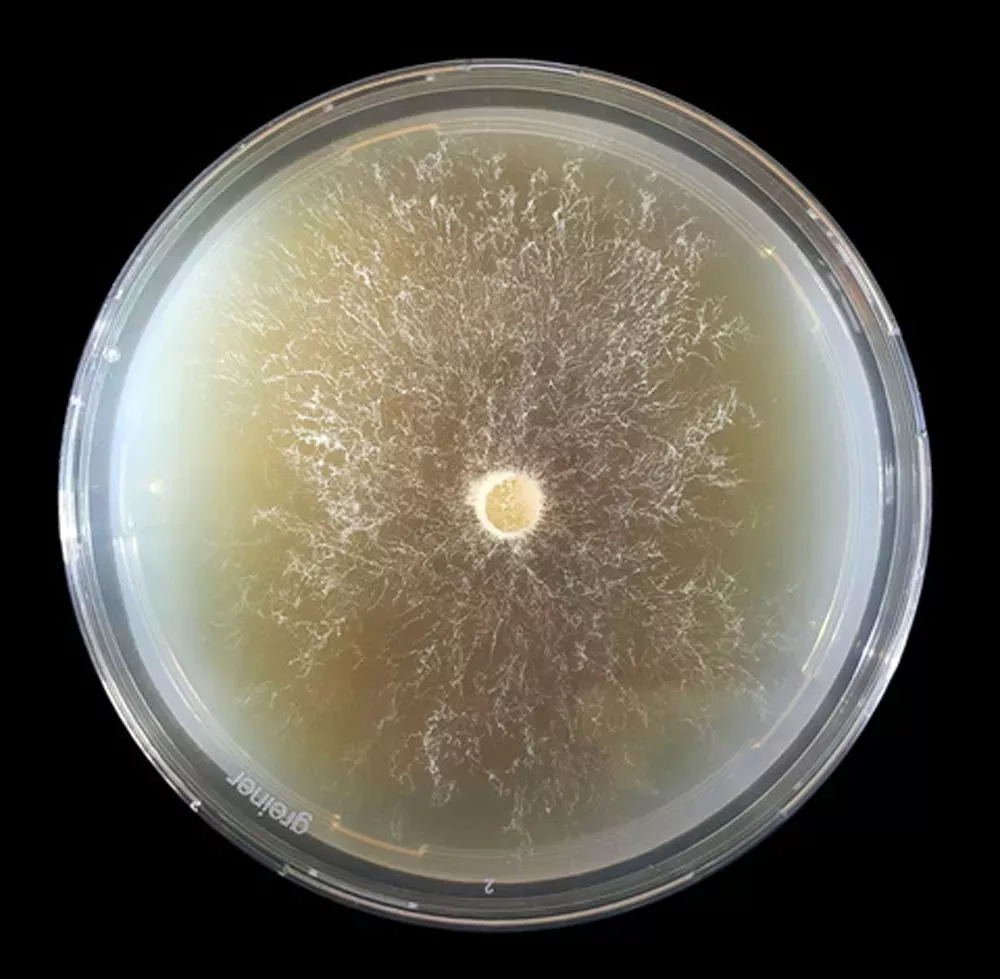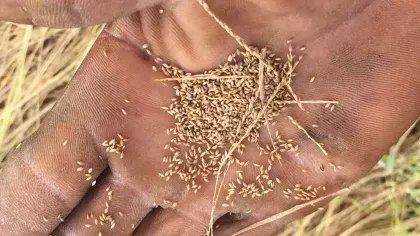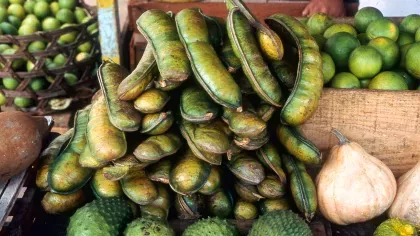4 March 2022
Chicken of the Woods
A favourite with fungi foragers, Laetiporus sulphureus has recently had its genome sequenced.

Laetiporus sulphureus commonly known as Chicken-of-the-Woods, is perhaps one of the most distinctive fungi in the UK.
Its bright orange-and-yellow colouring catches the eye, standing out clearly against the bark of the trees from which it grows.
The spore producing bodies, that are shaped liked shelves, are highly sought after by foragers because they are easily identified and can occur in large quantities.
When they are collected at an early stage, they have a soft fleshy texture and pleasant flavour that is, in some ways, comparable to chicken, hence its name.
There is, however, a great deal more to this fungus than its culinary value, as it plays an important ecological role in our woods.
And now, we have a fully sequenced genome for this species, made available through a major project that aims to sequence all eukaryotic organisms in the British Isles.

Wood decomposing fungus
L. sulphureus is a species of bracket fungus (or polypore) thought to occur on a range of different broadleaved tree species in the UK, including oak, sweet chestnut, ash, cherry, and even yew.
It's one of the key engineers of hollowing in veteran and ancient trees, particularly British species of oak, a role that creates microhabitats booming with biodiversity.
The fungus finds its way to the centre of trees to decompose the heartwood, the non-functional wood that sapwood converts to as it senesces.
A suite of enzymes is released by the fungus which modifies the lignin in the wood cell walls, allowing the decay of cellulose in a process called ‘brown-rot’.
The wood becomes brown, brittle and cracked and can be easily broken down further by mechanical processes or weathering.
This decay of heartwood is, in fact, an important and natural part of the ageing process for the tree and has several benefits.
The rotting heartwood releases nutrients locked up in the tree which can then be used in new growth.
Additionally, in some cases, adventitious roots can form on the interior of a developing hollow to gain early access to this private food source.
Oak trees will often respond to heartwood decay by producing buttress roots, increasing the angle at which the trunk is connected to the ground, thus creating better resistance to high winds.
In summary, it's as if the tree had been adding into a savings account year-on-year to be used later in life and the fungi were helping to unlock those savings.
A home for critters
It's not only trees that benefit from L. sulphureus. The dark crevices created by the fungus offer a woodland haven to invertebrates, including rare beetles, bees and ants, and to a host of small mammals, bats, owls, and other birds.
Even the fungal spore-producing bodies can become rich habitats to invertebrates, providing food and shelter.
Unfortunately, like other fungi that can rot living trees, L. sulphureus is often mislabelled as a pathogen, masking the important relationship that this fungus has with trees and often resulting in unnecessary felling.
Sequencing fungi
L. sulphureus is the first fungus to be sequenced in the Darwin Tree of Life project, an initiative under the wider Earth Biogenome project, that is working towards determining the DNA sequence of all 70,000 species of plants, animals, fungi and protists in Britain and Ireland and making the data freely available online.
A consortium of 12 institutions, including RBG Kew, is working together to collect and identify specimens, extract and sequence DNA and RNA, and assemble and annotate the genomes.
Kew is contributing plant and fungal expertise to the project, drawing on existing research and our collections to collect and barcode plants and fungi.
The L. sulphureus specimen that was sequenced was collected by ourselves from a veteran oak tree in Bristol.
By unlocking vast amounts of genetic data from the organisms around us, we will be able to better understand the evolution and diversity of life, find new medicines and conserve biodiversity for future generations.
With the genome of L. sulphureus now available, we can now expand our understanding of how these essential habitat-engineering fungi operate and interact in their environment.
This information may be critical to our ability to protect the myriad of organisms that rely on dead wood and tree-hollow habitats.
Furthermore, genome data will allow exploration of the potential medical and chemical applications that this species holds, potentially allowing the development of new medicines and biosynthetic pathways to help protect our futures.

References
Boddy. (2021). Fungi and Trees: Their complex relationships. Arboricultural Association UK.
Burdsall, H. H., & Banik, M. T. (2001). The Genus Laetiporus in North America. Harvard Papers in Botany.
Justo, A., Miettinen, O., Floudas, D., et al. (2017). A revised family-level classification of the Polyporales (Basidiomycota). Fungal Biology, 121: 798–824.
Khatua, S., Ghosh, S., & Acharya, K. (2017). Laetiporus sulphureus (Bull.: Fr.) Murr. as Food as Medicine. Pharmacognosy Journal, 9: s1–s15.
Krah, F. S., Bässler, C., Heibl, C., et al. (2018). Evolutionary dynamics of host specialization in wood-decay fungi. BMC Evolutionary Biology, 18: 1–13.
Minnich, C., Peršoh, D., Poll, C., & Borken, W. (2020). Changes in Chemical and Microbial Soil Parameters Following 8 Years of Deadwood Decay: An Experiment with Logs of 13 Tree Species in 30 Forests. Ecosystems 24: 955–967.
Ota, Y., Hattori, T., Banik, M. T., et al. (2009). The genus Laetiporus (Basidiomycota, Polyporales) in East Asia. Mycological Research, 113: 1283–1300.
Ryvarden, L., & Melo, I. (2017). Poroid fungi of Europe 2nd edition. Synopsis Fungorum 37: 1-431.
Song, J., Sun, Y. F., Ji, X., et al. (2018). Phylogeny and taxonomy of laetiporus (Basidiomycota, polyporales) with descriptions of two new species from western China. MycoKeys, 37, 57–71.




